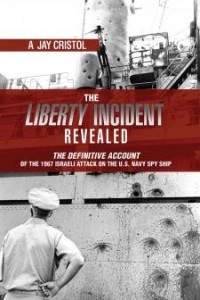 By A. Jay Cristol, Naval Institute Press, Annapolis, MD (2013)
By A. Jay Cristol, Naval Institute Press, Annapolis, MD (2013)
Reviewed by Stephen Phillips
On June 8, 1967, Israeli air and naval forces engaged in the Arab-Israeli Six Day War attacked USS Liberty (AGTR 5), killing 34 and wounding 171 Americans. The incident immediately caused a conflagration of controversy. Most accusations assert premeditation. Some suggest that the attack intended to prevent the surveillance ship from collecting information on Israeli activity. Others assert that President Johnson approved the action or assisted in the cover up. In The Liberty Incident Revealed, author A. Jay Cristol shows how the event was a tragic accident, not the cold-blooded murder of neutrals, using compelling evidence at the strategic, operational, and tactical level. He also addresses each of the Liberty conspiracies, showing how these theories, and in some cases the theorists, are full of holes.
Cristol begins by describing Liberty‘s role as a SIGNINT collector, or “spy” ship in laymen’s terms, and the supposition by Israeli ground forces that she was an Egyptian destroyer responsible for shelling Israeli ground forces in El Arish. The largest section of the book is an analysis of the event.
The U.S. was Israel’s most powerful ally in 1967. Any assertion that Israeli forces intended to attack Liberty must be balanced against the strategic damage that would ensue. What could be so important? Operationally, if Israel decided to risk its relationship with the United States, the attack would have to be well planned. The attack could likely come at night, for example. Instead, the event seems to be ad hoc, reactive rather than proactive. The three gunboats and two sections of aircraft responding were less than ideal. Even if engaging Liberty were opportunistic, to meet its supposed intent the attack would have been pressed, and Liberty would be sunk. Instead, upon one pilot’s recognition that the hull designation – ‘GTR’ – was in Roman, not Arabic writing, the engagement ceased and Search and Rescue helicopters were sent to offer assistance. Finally, any premeditated attack would be tactically very different, likely employing cover of night and a very different mix of forces. In fact, one of the most convincing pieces of evidence is that the Israeli Navy initially calculated Liberty was steaming at 31 kts. Thus, clearly in pursuit of an Egyptian destroyer, they called for air support to assist. Cristol suggests rivalry between the Israeli Air Force and Navy was so great, if the Navy knew Liberty, a large, slow vessel, was the target, they would have engaged her alone.
It is clear that much work went into this manuscript. Cristol’s research is thorough. His analysis is sound. There is much more to his study than presented in this review, including archival research, first person interviews, and material obtained through the Freedom of Information Act (FOIA). Although the topic lends itself to prose reminiscent of an insurance report or court document, Cristol’s writing is comfortable for any reader interested in the subject. Anyone interested in sea service, historical case studies, or simply a good read should pick up The Liberty Incident Revealed.
Stephen Phillips served in the U.S. Navy as a surface warfare officer and Explosive Ordnance Disposal (EOD) Technician. He is the author of The Recipient’s Son, a novel about the U.S. Naval Academy published by the Naval Institute Press.

